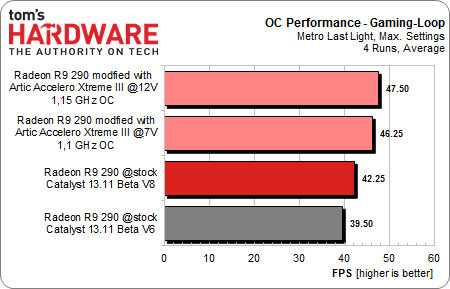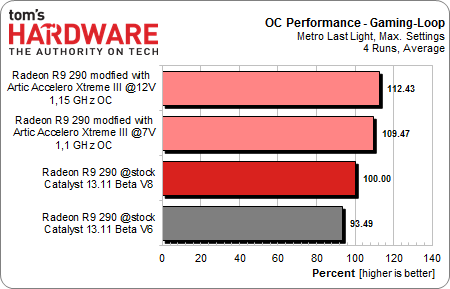Fixing The Radeon R9 290 With Arctic's Accelero Xtreme III
One of the best things we did for our Radeon R9 290 review was pop off AMD's reference cooler and attach Arctic's Accelero Xtreme III. Today, we show you how we did this, we dive deeper into the results, and ultimately recommend the aftermarket heat sink.
Temperatures, Overclocking, And Noise
Overclocking And Temperatures at 12 V
So, let’s test the real limits of this card's frequency. We can always dial the acoustics down later. With the R9 290's power limit set to +35%, I figured out that the maximum stable clock rate was somewhere around 1150 MHz using an hour of Metro: Last Light looping 24 times. It only took 10 minutes for each pass to hit its highest temperatures, and I maintained constant clock rates throughout, so there was none of the jumping up and down seen from AMD's reference cooler.
The following chart tracks thermals for the GPU and voltage regulators at two different clock rates.
Overclocking And Temperatures at 7 V
Now we know our overclocking limits (on air, anyway). What happens to the voltage regulators when we dial back fan speed with a 7 V adapter, though? It turns out that GPU stays nice and cool, but the VRM overheats. To maintain safe parameters, we measured everything again at a 1100 MHz ceiling and a +20% power limit. The 1150 MHz we were enjoying before is still possible, but then you're looking at almost-100 °C voltage regulator temperatures.
Real-World Performance Improvement
All of this adds up to an improvement in gaming, quantified by measuring average frames per second. Otherwise, a higher sustainable clock rate on its own doesn't mean much. You'll have to forgive the results with AMD's Catalyst 13.11 Beta 6 and 8 drivers. These numbers were all run before the company adjusted its fan control algorithm in the face of our investigative work.
Between when we received our original press board with AMD's original driver and our more recent overclocking effort using Arctic's Accelero, the Radeon R9 290 picks up nearly 20% more performance. Even after the Beta 8 driver with a 47% PWM limit, the modified card wins by 13%. Of course, by pushing the 290's fan speed even higher using Catalyst 13.11 Beta 9, AMD managed to eke out addition performance. At the same time, however, it made a very loud thermal solution even louder. clock speed gain. Arctic's Accelero Xtreme III gives you even more speed, without the unbearable whining.
Video Comparison Of The Aftermarket And Reference Cooler
First we're going to let you listen to both overclocked versions of our R9 290 with Arctic's cooler at 12 V (1150 MHz) and 7 V (1100 MHz). Then, you can check out the original Radeon R9 290 with its 47% PWM limit that was knocking our press card back off of its 947 MHz ceiling. Remember, Catalyst 13.11 Beta 9.2 makes the board even louder.
We present AMD's Radeon R9 290 GHz Edition, the way it should have been.
Get Tom's Hardware's best news and in-depth reviews, straight to your inbox.
Current page: Temperatures, Overclocking, And Noise
Prev Page Assembly And Operation Next Page No Surprise: Arctic's Accelero Xtreme III Is Recommended
Igor Wallossek wrote a wide variety of hardware articles for Tom's Hardware, with a strong focus on technical analysis and in-depth reviews. His contributions have spanned a broad spectrum of PC components, including GPUs, CPUs, workstations, and PC builds. His insightful articles provide readers with detailed knowledge to make informed decisions in the ever-evolving tech landscape
-
rolli59 I will wait and get the Gigabyte Windforce then I will not have to pay full price for the cooler. (just saying)Reply -
MauveCloud I can't find anything to confirm that you tested this inside a case, and I'm curious what it does to case and cpu temps compared to the reference card, and what it does to a second gpu running in crossfire mode.Reply -
CaptainTom I gotta say I agree with AMD's opinion that reference coolers are just there to get the job done as cheaply and consistently as possible since non-references will rule the market anyways.Reply
But at the end of the day reviewers are gonna continue to mark down cards for these silly things for whatever reason. AMD might as well just make the reference coolers at least as good as SAPPHIRE's Dual-X so that everyone shuts up... -
sha7bot I want AMD and NVIDIA to start selling their boards without a cooler. I can buy a waterblock from any number of retailers, but I can't get the damned GPU. Discount the boards and sell them OEM to us consumers.Reply
Also, try and make your layout a standard so I don't have to keep buying after-market coolers or blocks. I can just move them from board to board. -
FormatC @MauveCloudReply
I've proofed this construction in my Corsair Obsidian 900D and it works as described, I had to turn on my case fans but only @800-900 rpm. To test a crossfire setup I would have to destroy two cards - sorry, but this was too expensive for me. One modified card is ok, but I cant kill all my samples :D -
ingtar33 that 1150 clock speed is actually on the low side. on several other forums i frequent people are hitting mid 1300's pretty consistently with aftermarket air coolers, and 1400s on water.Reply
it seems the r9-290x is pretty much identical clock for clock to the 780ti... so putting a non-reference cooler onto it is almost mandatory; because when it's not temp throttling it's pacing nvidia's $700 monster. -
brainrazer I was going to say same thing as sha7bot. Overall though I hope one day we can buy a gpu and fan/cooler in drop it in the Mobo socket like a cpu. Hell even have multiple sockets in a row to take up less space at the end of the mobo to give room for pci slot devices. It always sucks having to decide between these graphics cards or "this" card and a sound card or ssd.Reply -
horaciopz Maybe, later on the road Accelero will launch a R9 290 version of this cooler as they did with the HD 7900 version.Reply
Also, look that, that cooler is barely spinning. You can squish more of it, that would be even more noticable in performance gains! -
s3anister "Obviously, if you spend $400 on a new Radeon R9 290 and immediately take it apart, your warranty is void."Reply
Are all the Vendor's cards like this? If I remember correctly Sapphire used to allow (or still does) people to take the stock cooler off to attach a waterblock without it voiding the warranty. -
bemused_fred Blimey, that is so much fuss to put together, not to mention the fact that it voids your warranty.. AMD have really, really shot themselves in the foot by not offering after-market cooling at launch.Reply



